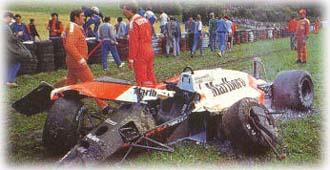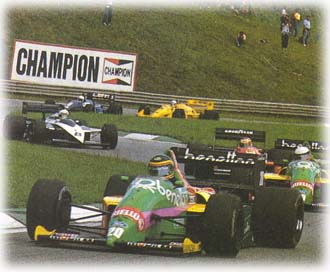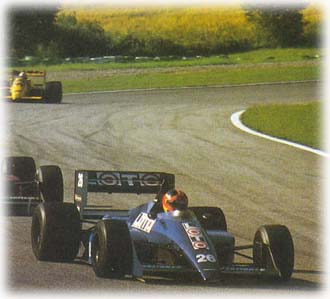| ATLAS F1 Volume 6, Issue 28 | |||
 |
A Race to Remember | ||
| by Marcel Schot, Netherlands | |||
|
Every Grand Prix Venue has its most remembered race; that race where the mighty gods of Formula One diced and dodged to achieve eternal greatness and set the record books straight. But every Grand Prix venue also has remarkable races that were pushed aside in the history books, for no good reason. Atlas F1 writer Marcel Schot reviews, ahead of every Grand Prix this season, one race which should be memorised and valued; that one round in history which makes a Race to Remember
After being left off the Formula One calendar for nine years, the Austrian Grand Prix made its comeback in 1997 on the renovated Oesterreichring, now named A1 Ring, after its new main sponsor. The circuit, which was removed from the calendar in 1987 for lack of finance and safety, was now a typical modern circuit and safe. Because of this, it was deemed to have lost its soul, as before the changes it had been one of the fastest and most spectacular tracks around the globe with average race speeds topping 230 km/h.
The race that stands out when one remembers the Austrian Grand Prix must be the 1987 race. Not as much for the actual racing, but more for the overdose of action both in practice and the race. Most of this action proved to be the final blow for the Austrian Grand Prix in its losing battle with the Hungarian Grand Prix over a single spot on the calendar.
Before the race
The weekend started with Nelson Piquet as the favorite after having won the two previous races, thereby claiming the lead in the championship with 48 points. Ayrton Senna was second, eight points behind his countryman. In third and fourth were Alain Prost and Nigel Mansell with 32 and 30 points, a long way behind Piquet. The Ferraris had proven powerful, but extremely unreliable. Gerhard Berger had scored nine points thus far, while Michele Alboreto had one less.
As said earlier, the Williamses of Piquet and Mansell battled for Pole, with the Brazilian coming out just on top with a 1:23.357, one tenth faster than his teammate. In third was Ferrari driver Gerhard Berger, who was reasonably happy with his spot on the grid. Between Berger and his teammate Michele Alboreto were two surprising cars. Both Benettons felt at home in the Austrian hillside, Thierry Boutsen taking fourth ahead of Teo Fabi. Ayrton Senna in the Lotus qualified seventh, a place the Brazilian qualifying ace wasn't used to. World Champion Alain Prost took it easy after Johansson's accident, qualifying only ninth. AGS driver Pascal Fabre had the dubious honour of being the slowest qualifier by far, posting a time over 17 seconds slower than Piquet's pole time.
This all took place in the first qualifying session as rain spoiled the second session. On day two, not even all drivers took to the track. Mansell turned in the fastest lap by far, but his 1:33.779 was only a shadow of the previous session's times. Second in the session was surprisingly Arrows driver Eddie Cheever, who nonetheless set a time four seconds slower than Mansell.
The race
So after the track was cleaned, the cars lined up for a second attempt to start the race. This time Berger had both Benettons close to his gearbox, but this time the problem was on the other side of the track. On the front row, Nigel Mansell had stalled his Williams. The first few cars managed to steer around the slow starting Williams. However, the drivers at the lower end of the grid had started normally and were approaching a fair speed when they stumbled upon Mansell and the cars braking behind him. The result was a pile of approximately twelve Formula One cars, a havoc never to be seen until David Coulthard's spin in Belgium in 1998 triggered a 14 car pile-up in heavy rain.
The main problem occured when Eddie Cheever went around the outside of both Brabhams. Andrea de Cesaris' car wasn't a big hurdle to take, but Riccardo Patrese thought of the same thing as Cheever and also went around the outside to pass Mansell's car. Patrese and Cheever clipped wheels as they were trying to squeeze through a gap that was about one and a half cars wide. With Cheever pressed firmly against the guardrail and Patrese dropping back down half in front of the rest of the field, all hell broke loose again. Once again, there was only one real victim. Alex Caffi's Osella was too damaged to race. However, for the unfortunate Italian there were no more cars available to him.
At start number three everybody was a bit more careful and they were finally off for their 52 laps through the Styrian mountains. Mansell again was slow to leave his place on the grid, having to let Berger and Boutsen past as Piquet went into the first corner in the lead. Thierry Boutsen was all over Piquet, with Gerhard Berger in third and Mansell fourth with the other Benetton of Fabi on his tail. However, it soon became apparent that the power of the Williams was just too much for the competition. After four laps Mansell simply outpowered Berger at the end of the start finish straight. Boutsen was still ahead with Piquet, the two a little over three seconds ahead of Mansell. By then both Minardi's had already retired with technical problems. After all it looked like the second start used up all their luck, since they were about the only cars from the back of the grid who passed the crashing mayhem unharmed.
When Mansell returned from his scheduled pitstop in lap 25, it became apparent that the Briton had made the right choice by staying out longer. Mansell still led after his stop and even though Piquet set a new fastest lap on fresh tyres after his pit stop, Mansell wasn't impressed. He responded with a slightly faster time, setting the definitive fastest lap at 1:28.318. A long way behind them, Alboreto, Senna, Prost and Fabi battled their own battle, dodging and diving for the remaining points. In the ongoing process, both Brabhams and both Arrows retired with mechanical problems, reducing the field to 17 cars. The final car to drop out of the race was Michele Alboreto's Ferrari, who suffered the same problem as his teammate: a blown turbo.
After Mansell's fastest lap Piquet seemed to give up, as Mansell steadily lapped no less than 1.5 seconds faster than the Brazilian. In the end, Piquet was the only driver not to be lapped by Mansell. After just under one hour and 19 minutes, Mansell took the chequered flag and a well deserved win. Just behind the winner, Benetton's Teo Fabi crossed the line to claim third. Pascal Fabre was the third driver to cross the line, but obviously not in a position that allowed him points. The 27 year old Frenchman was no less than seven laps down. Piquet claimed second place some 55 seconds behind Mansell. Boutsen had made a great comeback after his early problems with Piquet, taking fourth with Ayrton Senna and Alain Prost rounding up the top six, two laps down and two seconds between the two future archrivals.
Conclusion
I could make this short and say that two piles of cars and a car versus deer collision in one weekend of Formula One are great value for money, but of course things aren't as easy as that. True, these events are still the ones that are most remembered about this race, but the race was also a splendid display of Nigel Mansell's racing. The Briton gave his teammate and title enemy Piquet a serious mental slap in the face. It was the start of a turnaround in the championship, which was only kept from being completed when Mansell crashed badly in Suzuka, ending his title chase two races before the end of the season. On a second note, this race also showed the tremendous power and dominance of Williams in 1987.
|
| Marcel Schot | © 2000 Kaizar.Com, Incorporated. |
| Send comments to: schot@atlasf1.com | Terms & Conditions |


